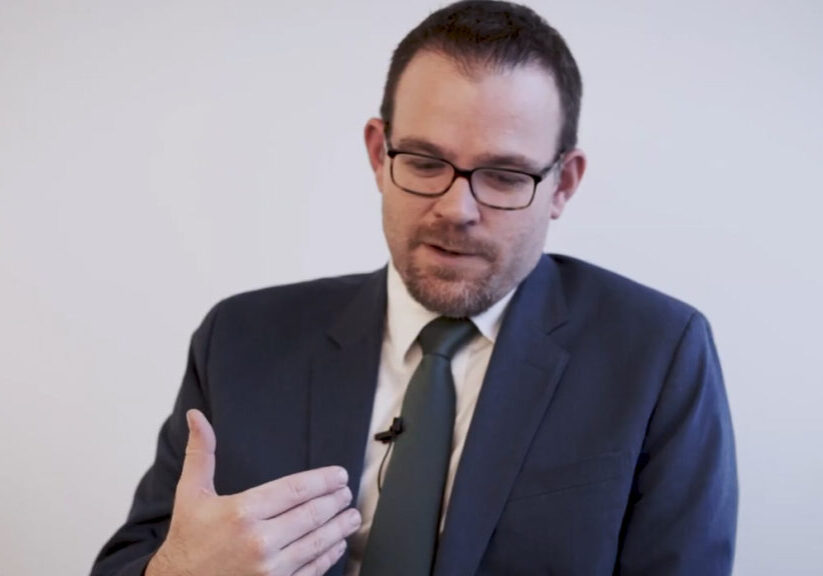Residential Segregation and Racial Inequality

“…central obstacles for black Americans seeking to make their way in post-war America.”
Historian Heath Carter discusses how post-war policies and practices (including the G.I. Bill, redlining, and restrictive covenants) created a Northern Jim Crow.
Transcript for Residential Segregation and Racial Inequality
So for people to understand 21st century Gary, I think they really have to go all the way back to the beginning. Gary is not some kind of a cosmopolitan place in the sense of, you know, it’s not like walking around Manhattan in the 21st century or something where you just kind of run into everybody—anybody and everybody wherever you walk. Gary was from the very beginning, like Chicago, like Detroit, like so many other Northern cities that are incorporating for the first time large numbers of workers of color, especially black workers, rigidly segregated, and segregation is different than in the South.
Oftentimes in the South, black people and white people live alongside one another, but it’s very difficult for black persons to advance up the social ladder. In the North, sometimes there are actually some employment opportunities for black workers and, in some cases, unions that include black workers. There’s a lot of racism, too, but in Gary, as in Chicago and these other urban centers in the North, residential segregation is quite rigid. Black workers are really cordoned off into a very small part of the center of the city. And all around them you would’ve had ethnic white neighborhoods that fiercely defended their borders against the possibility of black residential mobility.
Until the 1940s in Gary and in many Northern cities, you have these restrictive covenants which are actually legal documents that are in many cases included in deeds and that dictate who can live in a particular part of the city. These documents —restrictive covenants—are used to sort of preserve the quote-unquote racial integrity of neighborhoods. But even, you know, after those are declared illegal by the Supreme Court in 1948, segregation is preserved in the North. This is not just a Southern phenomenon. But it’s preserved in the North in a variety of other ways: through custom, through violence, through redlining, and through the knowledge that, you know, if you were black and you tried to buy a home in a white neighborhood, it would be very difficult to do so.
So redlining is one of the real engines of racial inequality in the mid-20th century United States partly because so many white Americans, you know, came into the middle class through the housing market, and they did so especially through the G.I. Bill.
The G.I. Bill was this piece of legislation passed by the federal government that effectively gave a whole generation of veterans the opportunity to get homes very cheap with FHA—Federal Housing Administration—mortgages and to get free college, education. And the legislation itself was actually race-neutral, colorblind legislation that says nothing about race. You’d think, “Oh, well, maybe black veterans could take advantage of this legislation as well.”
But the G.I. Bill, which really fueled the rise of the white middle class also was an engine of racial inequality partly because it was, in fact, impossible for black veterans to go to white colleges in the late 1940s and 1950s. Historically-black colleges and universities were packed to the gills with black veterans. They could not meet the demand. And meanwhile, black veterans found themselves effectively unable to take advantage of the G.I. Bill’s offer of a cheap FHA subsidized mortgage. This was because of the practice of redlining.
Redlining is named for these maps that were used in conjunction with FHA mortgages. If you pull up one of these maps, you’ll see neighborhoods that are color-coded: yellow, green, blue, and red. Red were what the Homeowners’ Loan Corporation thought, at least, were the highest-risk neighborhoods and those were neighborhoods that had high concentrations of persons of color. Fundamentally, at some level, the grading system governing these maps reflects kind of just a racist point of view on the mid-20th century American city where, in many ways, race is being taken as a proxy for risk.
If you’re an African American veteran who’s going into a bank to try to take advantage of the G.I. Bill, the banker would say, “Oh, where’s the home you’d like to buy? Oh, it’s in this neighborhood? Let me pull up my map.” They’d look on the map, if they didn’t already know. And that neighborhood’s graded red which means that it’s considered too risky for them to give you an FHA subsidized loan. And so this—what this meant— redlining meant—Black Americans were effectively boxed out of the housing market, and black residents find themselves crammed into very tight quarters and are paying, often, an incredible premium. They’re often paying vastly more for rent in a kind of very challenging neighborhood than they would pay for a mortgage in a middle class white neighborhood. So this was one of the sort of central obstacles for black Americans seeking to kind of make their way in post-war America.
Hold a Conversation
Can you imagine leading a conversation about this story? Where? With whom? What kinds of questions would you pose? (See How to use the questions for reflection for one approach.) Please email your questions to us or post them in the comment box for our consideration. If you use them in an actual discussion, let us know how the conversation went.
